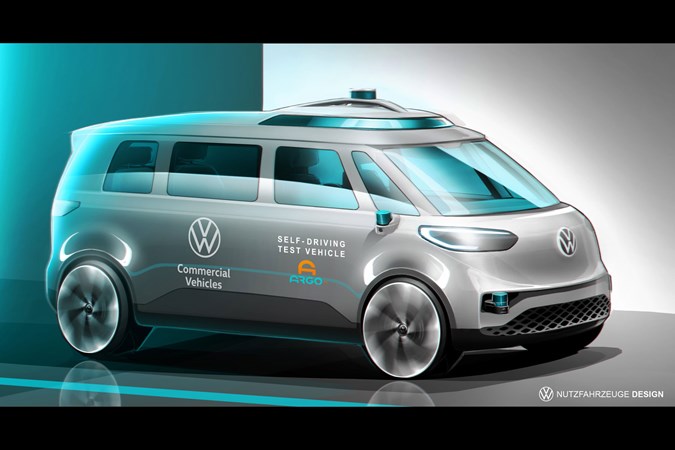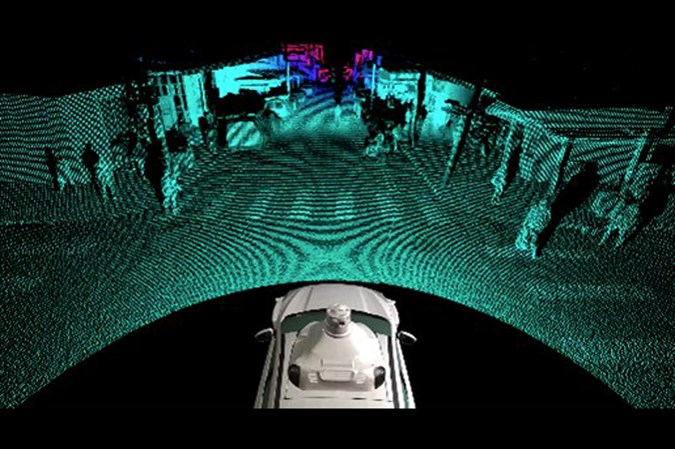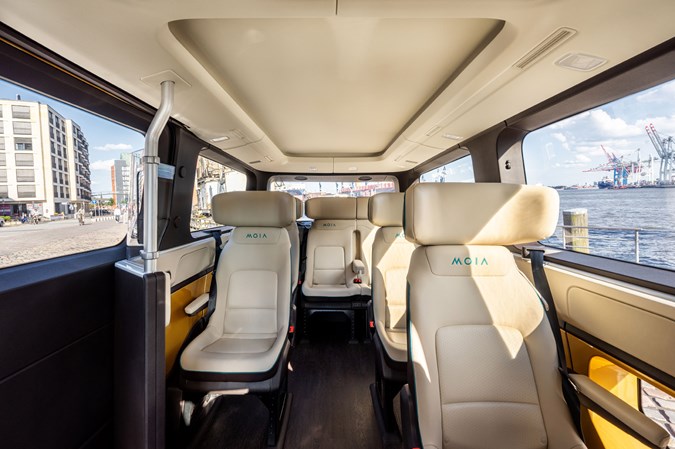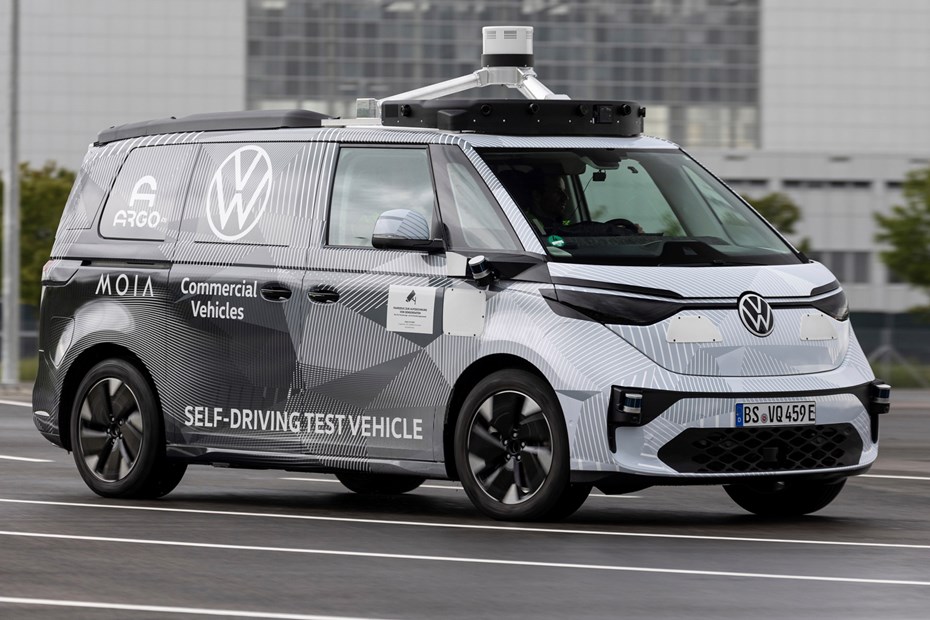Volkswagen has publicly revealed the first prototype version of a self-driving van, based on the forthcoming ID.Buzz electric van. Shown at the IAA Munich motor show, five examples are set to begin testing this year.
This follows Volkswagen Commercial Vehicles’s announcement earlier in 2021 of its plans to start building fully autonomous vehicles that can drive themselves in complex environments such as city centres and in all kinds of weather. Working in cooperation with Argo AI and VW’s own ‘ridepooling’ division, MOIA, prototypes will be roaming the streets of Hamburg by the end of 2021 ahead of a more serious ‘commercial deployment’ in 2025.
Sound ambitious? We agree. But VW is absolutely serious about this, and is working hard with its partners to put everything in place – which includes cutting edge sensors, high-power computing and a very clever algorithm – in order to develop a ‘digital driver’ that’s safer than a human one.
The self-driving technology is being incorporated into the production version of the ID.Buzz – which is expected to be called the ID.7 when it reaches showrooms, though that’s not been confirmed at this stage. This is an all-electric van, roughly equivalent in size to a current Volkswagen Transporter, and set to be available in cargo and passenger carrying variants that will form the basis of ‘Special Purpose Vehicles (SPV), such as robo-taxis and vans’ for companies including MOIA to use.

Autonomous driving tech comes in several levels. At the least ambitious end of the scale, these cover adaptive cruise control and lane-keeping assistance; but VW is talking about proper urban autonomous driving – Level 4 and above – particularly in the form of ‘ride-hailing’ that will take MOIA’s customers between inner-city locations without a human behind the wheel.
>> Sign-up for the Parkers Vans and Pickups newsletter
The first autonomous VW will be a van?
Not exactly. As MOIA is the testbed for VW and Argo AI’s cooperation, autonomous passenger carrying vehicles – specially optimised ID.Buzz minibuses, essentially – will come first.
Once the safe, self-driving algorithm has been cracked, however, there are then plans to move on to autonomous delivery vans. The tricky bit here is that without a driver onboard you have an issue of how to get the packages into customers’ hands. This could be done by people meeting the vehicle and getting access to a specific locker to retrieve their goods, but smaller delivery units that could split off from the main vehicle and go right to the door are also being explored.
So, tricky. But that’s not to say the ride-sharing model is without challenges. A human driver can easily check whether the number of people getting on match the number of people on the booking, make sure they put their seatbelts on and safely stow their luggage, and check for items left behind – any future digital driver needs to be able to do the same. Meaning it’s not just self-driving software that requires development here.
In fact, the self-driving could even prove the easier part.
Where does Argo AI come in?
Volkswagen CV and alliance-partner Ford have ‘invested equally’ in Argo AI to help them develop self-driving vehicles, the firm having already carved itself a niche specialising in software platforms for autonomous driving’. It’s self-proclaimed mission is ‘to build self-driving technology you can trust.’
We’re not talking about pocket change here. VW (almost casually) refers to an ‘initial investment of one billion US-Dollars’ – that’s currently around £717 million – plus has moved its own subsidiary AID (Autonomous Intelligent Driving) into Argo as well. A further ‘budget for autonomous driving’ was confirmed by the Volkswagen Group supervisory board in February 2021.
Argo AI is already operating test vehicles in six cities in the USA, with the new Volkswagen trial set to begin in Hamburg, Germany, this year. To this end, a test track has now been established alongside the airport. Similar to a facility Argo has near its headquarters in Pittsburg, USA, this will allow the simulation of traffic and pedestrians in a real – rather than virtual – environment, before the prototypes are unleashed in Hamburg traffic.
This will be happening in 2021, though. In contrast to other autonomous driving programmes, Argo’s approach is always to start with complex situations on a small scale, then gradually expand as the algorithm learns and gets smarter. Both right-hand drive and left-hand drive scenarios will be tested.

Helping with this is the Argo AI lidar – a unique long-range (400m) ‘very high definition’ sensor system that works with shorter-range (200m) lidar, radar and cameras as well as high-resolution mapping to give the vehicle a 360 degree view of its surroundings. This is different to current production sensor packages, which concentrate on forward and rearward ‘perception’. A fully autnomous vehicle will need to be completely aware of everything around it.
The Argo lidar works in poor weather and has a proprietary ‘Geiger-mode’, apparently able ‘to detect the smallest particle of light – a single photon – which is key to sensing objects with low reflectivity.’ Using the high-powered computer system carried onboard the vehicle, it’s capable of tracking ‘thousands’ of objects at once, including pedestrians and cylists no matter which direct they are approaching from.
Both Argo and VW are keen to highlight that their autonomous vehicles will put safety as the highest priority, and use this ‘fusion’ of cameras, radar and lidar collectively in order to build up a complete picture of the surroundings, each sensor type compensating for short-fallings in the others.
Self-cleaning capability is also important for this – something that Argo tests extensively on its test tracks, using a ‘mud cannon’ among other tools to do so.
What’s the ultimate aim here?
In 2025, Hamburg will become the first city to offer fully autonomous end-to-end ridepooling using ID.Buzz vehicles operated by MOIA.
The autonomous driving system will be ‘fully integrated’ into the all-electric ID.Buzz. The ridepooling aspect is important as a more professional alternative to ride-sharing operations such as Uber and means to enable mobility for all while reducing urban traffic and improving air quality (hence MOIA already only uses electric vehicles).
For this to work, the ridepooling service has to be as reliable and easy as using your own car, something MOIA hopes its own clever software and infrastructure will quickly demonstrate. It also has to be something customers enjoy, as this comes in part down to the choice of vehicle – the retro-modern ID.Buzz would seem a perfect choice; MOIA current uses a fleet of specially adapted VW Transporter Multivans with individual seats, passenger info screens and fast Wi-Fi.

Once this autonomous ‘Mobility as a Service’ (MaaS) is up and running successfully, the plan is to then move on to ‘Transport as a Service’ (TaaS) and begin solving the autonomous delivery challenge. The same ‘digital driver’ will work for both, and to reiterate, the idea is that this digital driver will be safer than a human one by this point.
To quote the CEO of VWCV, Carsen Intra: ‘With the confirmation of the [VW Group]’s supervisory board for our Autonomous Driving R&D program, we are setting the course for the future of mobility. Autonomous, electric driving will make an important contribution to urban mobility and road safety. Our vehicles are the logical first choice to apply such systems to.’
Won’t this put scores of human drivers out of work?
Perhaps eventually. But MOIA claims that there aren’t enough drivers at present anyway, and that it will be along time before autonomous driving completely replaces human beings. Initial it will be filling a gap – with the promise of increased safety.
Any other news about the ID Buzz?
Just to recap, the ID Buzz is an electric van that will come in passenger and cargo variants. Roughly the size of today’s Volkswagen Transporter, it’s expected to be called the ID.7 when it goes into production and is based on the VW Group’s dedicated electric vehicle platform, known as MEB.
The ID Buzz / ID.7 will get its world premier in 2022 (we’ve already seen concept versions of both the passenger model and the van) and is being built in the old Amarok factory in Hanover.
We can’t wait to find out more, including whether there’s going to be a Ford version – which would make some sense given Ford and VW are working closely together on future commercial vehicles and Ford’s use of Volkswagen’s ID electric vehicle platform for cars.
Also read:
>> VW ID Buzz Cargo all-electric van concept world debut
>> Project Cyclone: Ford and Volkswagen strategic alliance – full details
Just so you know, we may receive a commission or other compensation from the links on this website - read why you should trust us.










